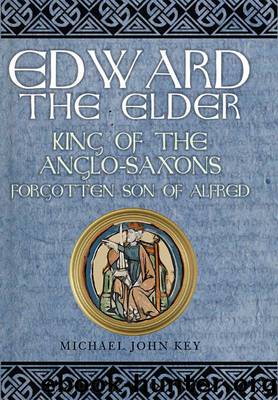Edward the Elder by Michael John Key

Author:Michael John Key
Language: eng
Format: epub
Publisher: Amberley Publishing
Published: 2019-01-18T16:00:00+00:00
15
The Danelaw Campaign – First Phase 912–914
Edward’s military accomplishments during the second half of his reign should not be undervalued. The chapters that follow recount these events, particularly between 912 and 919, in some detail. It has been seen as an achievement described as, ‘… representing one of Medieval Europe’s most remarkable and sustained military comebacks’.1 The war against the Danelaw would be uncompromising and dynamic. Once territory was won Edward would build fortified garrisoned burhs which permitted civil and military control of localised regions.2 He used the burh system as an offensive weapon. The death of Æthelred of Mercia may have been a watershed moment in how Edward sensed his destiny, and the offensive against the Danelaw began soon after Æthelred’s death. This points perhaps to an idea of a renewed West Saxon and Mercian solidarity, that of family solidarity, that could only be enacted once his sister Æthelflæd had assumed full authority in Mercia.
Together, Edward and Æthelflæd’s drive and determination are clear within the limited primary source texts. They had both inherited the resolve and passion of their father, but unlike Alfred, who was forced to compromise to secure the future of Wessex and the survival of Anglo-Saxon England for most of his reign, they could look from 912 towards expansion. By 911 or 912 Edward had probably formulated his own vision to re-establish Anglo-Saxon rule across some of the former West Saxon and Mercian lands lost previously. This was at that stage no doubt a restricted vision with modest goals, but it would expand and become ever wider as his military successes mounted. However, the control of territory was not the whole picture. The cultural and social fabric of what was now the Danelaw region had changed since their father’s treaty with Guthrum. The population of that region was still overwhelmingly Anglo-Saxon, but there had been nearly two generations of Scandinavian settlers that had made their mark on the land. They had interbred with Anglo-Saxons and settled as Anglo-Scandinavian. It had passed beyond the stage when they could be eradicated, evicted and replaced. They were already an integral part of the English fabric and represented the future economic prosperity of the land they considered their own. To keep authority in the Danelaw, if or when gained, Edward therefore needed to see both Anglo-Saxon and Dane as equals, or to appear to, and treat them as such. It must be expected that he had learned considerably from witnessing first hand his father’s practical rationalism, and had mixed it with a new sense of realism.
Permanently re-establishing the authority of an Anglo-Saxon king would only be achieved looking beyond warfare towards unification. However, prospects of that were still some way off in 911. Edward’s expectations can only be surmised. How he proceeded would depend on his relationship with his sister. They had already agreed the peaceful transfer of the administration of London and Oxford to Wessex. Æthelflæd’s full co-operation was critical. Edward needed to be mindful that he did not
Download
This site does not store any files on its server. We only index and link to content provided by other sites. Please contact the content providers to delete copyright contents if any and email us, we'll remove relevant links or contents immediately.
| Military | Political |
| Presidents & Heads of State | Religious |
| Rich & Famous | Royalty |
| Social Activists |
Waking Up in Heaven: A True Story of Brokenness, Heaven, and Life Again by McVea Crystal & Tresniowski Alex(37671)
Empire of the Sikhs by Patwant Singh(22974)
We're Going to Need More Wine by Gabrielle Union(18967)
Hans Sturm: A Soldier's Odyssey on the Eastern Front by Gordon Williamson(18483)
Leonardo da Vinci by Walter Isaacson(13181)
The Radium Girls by Kate Moore(11921)
Tools of Titans by Timothy Ferriss(8216)
Educated by Tara Westover(7941)
How to Be a Bawse: A Guide to Conquering Life by Lilly Singh(7391)
Permanent Record by Edward Snowden(5737)
The Last Black Unicorn by Tiffany Haddish(5558)
The Rise and Fall of Senator Joe McCarthy by James Cross Giblin(5228)
Promise Me, Dad by Joe Biden(5087)
The Wind in My Hair by Masih Alinejad(5033)
A Higher Loyalty: Truth, Lies, and Leadership by James Comey(4843)
The Crown by Robert Lacey(4722)
The Iron Duke by The Iron Duke(4291)
Joan of Arc by Mary Gordon(4013)
Stalin by Stephen Kotkin(3875)
